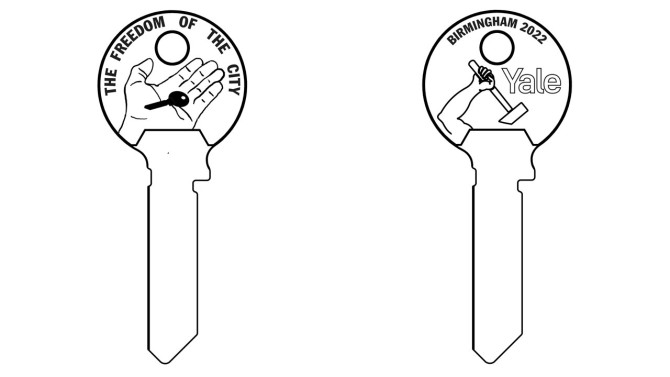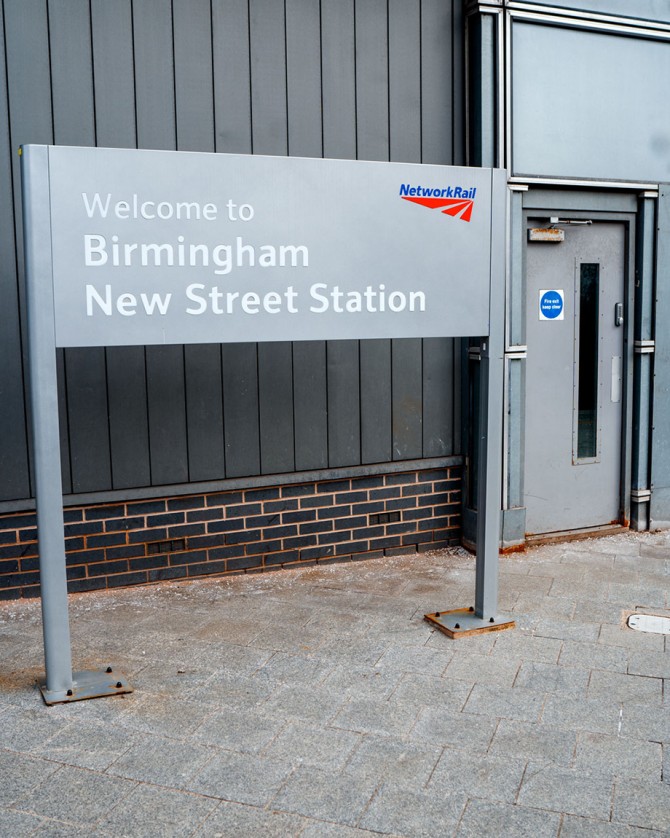UK-based public art project offers any person ‘key to the city’
At the Birmingham New Street train station in England, a locked door at the end of Platform 1 typically goes unnoticed amid the daily bustle of the city’s busiest commuting hub.
Over 10 weeks starting May 28, a key designed by Paul Ramírez Jonas, chair of the Department of Art in the College of Architecture, Art and Planning, will allow thousands of residents and visitors to pass through it, beginning a Harry Potter-like journey deep underground to a service tunnel where green ferns grow beneath fluorescent lights.
“It’s just weirdly magical,” Ramírez Jonas said.
The site is one of more than 20 public, private and commercial spaces that will be made accessible as part of “Key to the City 2022,” the latest iteration of a public art project Ramírez Jonas has explored on small and large scales over nearly two decades, most notably in New York City in 2010.
Together the sites – also including a mosque, museum, restaurant and private garden – present a fresh portrait of the sprawling and diverse industrial city, and raise questions about the nature of public space; about trust, fear and what it means to be a neighbor; and about the role of civic monuments.
“We take something symbolic, that claims to be a key to the city, and make it actually open places that represent the city,” Ramírez Jonas said. “And instead of only a few privileged people getting it, any person can give the key to whomever they want, for whatever reason they want.”
The Birmingham arts organization Fierce had long been interested in producing “Key to the City.” The opportunity finally arose as part of the Birmingham 2022 Festival, supported in part by the Commonwealth Games, which the city will host later this summer.
“The project captures people’s imaginations,” said Aaron Wright, Fierce’s artistic director.
Birmingham first awarded honorary “freedom of the city” in 1888 to Joseph Chamberlain, the British statesman and former mayor of the city, and fewer than 75 people and military units have received it, according to city records and Wikipedia.
Soon, a booth at Birmingham New Street Station will invite visitors to present the honor, in the form of a key, to a friend, loved one or potentially even a stranger. In formal ceremonies, “Key to the City 2022” participants will cross red carpets to a pedestal, state to whom they are awarding a key and why, and record their names in a ledger that will be maintained in city archives.
“You’re participating in the bestowal of this civic medal, essentially,” Ramírez Jonas said. “You decide who should be honored in this city.”
In New York, where people waited in lines to claim 19,000 keys to the city (after the mayor temporarily ceded authority to grant them), Ramírez Jonas said those ceremonies often were emotional exchanges. In Birmingham, up to 15,000 participants will receive a Yale key engraved with a hand offering a key on one side and detail from the city’s coat of arms on the other, along with a passport cataloging the sites that agreed to take part in the project.
From the service tunnel, keyholders could progress to an office tower for a bird’s-eye view not easily found in the flat city. They could open a cabinet inside a geology museum, or a door tucked in the brick arch of a 230-year-old bridge at the city’s edge. At an Indian restaurant, the chef will share a menu of his mother’s recipes. A mosque will welcome guests to observe prayers.
Elsewhere, the key will unlock a side door to a sports stadium, enable passage through a shopping mall on a street gated shut overnight, and provide entry into a family’s small private garden.
“They spoke eloquently about the idea of how to be a good neighbor, and it was very moving,” Ramírez Jonas said of the family. “That’s where this project is sometimes sweet, and sometimes has real teeth.”
For Ramírez Jonas, “Key to the City 2022” continues a long-standing interest in public monuments. At most statues of prominent historical figures, he said, one sees people eating lunch with their backs to them or skateboarders practicing tricks – evidence that they no longer function as cultural artifacts. What, he wondered, might inspire deeper connections today?
Though his keys are widely dispersed and their utility is short-lived, Ramírez Jonas said they forge meaning by blending public and private, fusing a civic symbol with the feelings and motivations of the people who bestow or receive it.
“Don’t we want to own our civic symbols?” he said. “The way they become meaningful is through a real sense of ownership and participation. By allowing people to participate with this civic symbol, they also regain ownership of it.”
“Key to the City 2022” runs from May 28 through Aug. 7.



